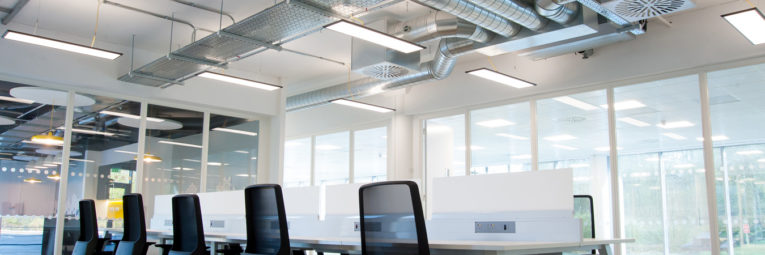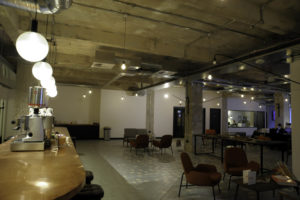
As lighting experts, it’s vital that we’re always on top of the latest industry guidelines and regulations. A new EN 12464-1 standard has recently been introduced, which will have a significant bearing on how lighting systems are designed for working environments moving forward.
For nearly 20 years, EU member countries have worked to a common standard for lighting interior workplaces. Earlier this year, the new European version was introduced and, among other changes, it takes a much more granular approach to locations and the tasks being performed by the workers.
This new standard covers everything from offices to retail outlets and from restaurants to libraries. Our blog explains what it means for lighting companies like ourselves, the companies we work for and the employees who work for them.

For anyone who doesn’t have the time to read the whole blog, here are the main changes summed up in a single paragraph: Most importantly of all, the structure of the standard has been changed to add more detail to the tables, putting more emphasis on the varying needs of different end-users working in different environments. The tables now also include requirements for walls, ceilings and cylindrical illuminances. Other additions include more advice on applying the requirements when designing lighting solutions and new information that clarifies glare requirements, as well as the impact of visual and non-image forming effects of light.
For those of you still with us (and we’re glad that includes you), let’s take a look at what’s changed in a little more detail.
Reasonable quality of lighting has been required for many years to enable workers to perform tasks efficiently. However, the new standard specifies the minimum lighting requirements of individual working areas rather than the room as a whole. It takes into account three different measurements: lux values, the Unified Glare Rating (UGR) and colour rendering.
Lux (lx) is the standard unit of measuring the level of light intensity. The UGR quantifies the extent that luminaires and light sources can cause discomfort. The colour rendering index (CRI) measures how colours look when illuminated by a luminaire in comparison to natural sunlight. Daylight has a CRI of around 75, and a minimum colour display of more than 80 now applies throughout the workplace.
As well as separate working spaces having their own individual lighting requirements, there are also specifications for general areas such as company car parks.
To give you a better idea of the differences involved, the table below details the required measurements of a selection of areas in the working environment.
| Area | Lux | UGR |
| Office | 500 | 19 |
| Technical drawings | 750 | 16 |
| Footpaths | 100 | 28 |
| Average industrial work | 300 | 25 |
| Refined industrial work | 500 | 22 |
| Stairs and escalators | 150 | 25 |
Originally, the standard specified requirements for computer displays and the areas around them. However, taking into account new learnings on ambient areas, the standard was extended to include requirements for ceiling, wall and cylindrical lighting.

While we won’t attempt to cover all the elements of the new standard in this blog, it’s well worth taking a closer look at some of the requirements.
The collection of tables specifies requirements for illuminance for a variety of tasks in a range of working environments including offices, schools, healthcare facilities and industrial premises. The standard requires 500 lx illuminance for the typical office workplace. It specifies varying illuminances for each specific task and type of room, from 30 lx–100 lx. For walls, this is usually 50 lx–150 lx.
With indirect lighting, the average luminance on the ceiling should remain at less than 500 cd/m². However, in specific areas, a maximum luminance of 1500 cd/m2 is allowed. The gradient should not be so steep that it makes the lighting in the ceiling distracting to those working in the room. At the same time, luminance uniformity (Lmin/Lavg) should not exceed 1:10.
We’d like to emphasise that we’re fully behind the increasing demands of the new standard, but it’s our inclination to try and push things even further. The standard specifies minimum requirements but, at Phi, we believe in providing more light than the regulation demands to make life easier for workers and, in turn, more productive for the business.
It’s also important to say that this isn’t just about working efficiencies. There is a rapidly growing body of evidence that a good level of lighting in the workplace has health and wellbeing benefits for employees. Get the quality of lighting right and it would be true to say that everyone benefits.
If you would like to find out more about our lighting solutions, please get in touch with one of our friendly experts today.
I can rely on Phi being proactive on issues arising.
Relationships & Empathy
Phi understands us, our scope and our limitations.
Relationships & Empathy
Phi delivers a good solution, which is more than just a product. Their service is good, they talk through schemes with us and there is more to it than just a catalogue.
Technical Skills
The main asset of Phi is people and the high level of technical backup they provide. For example with their competitors I meet a salesman and not a technical salesman. This difference is crucial.
Technical Skills
Good quality products at a reasonable price.
Price
Phi is not the cheapest supplier but they offer quality architectural fittings.
Price
Phi’s personal service is appreciated and differentiates them.
Service
During completed projects, we have been happy with the performance and communication from Phi. I can rely on Phi being proactive on issues arising.
Service
I see Phi for architectural led office foyers, reception areas, bespoke spaces in office blocks and good architectural lighting for commercial developments
Spaces
Appropriate for the commercial sector in particular and other places where there is a modern style requirement as befits their current product range.
Spaces
Phi is most suited to commercial offices, associated rooms and educational buildings.
Spaces
Phi delivers a good solution, which is more than just a product.
Perception & Image
We are project focused; there are lots of people in the industry but it is questionable whether they want to help and support properly. Why change to someone who may let you down, you stick with the best.
Perception & Image
Phi is not mainstream but a specialist niche architectural supplier who is a little bit different.
Perception & Image
Phi offer support, which sets them apart.
Perception & Image
Phi is a strong quality architectural supplier, giving good advice where we are lacking.
Perception & Image
Phi offer a great level of experience, supply, service and back up.
Perception & Image
I can rely on Phi being proactive on issues arising.
Relationships & Empathy
Phi understands us, our scope and our limitations.
Relationships & Empathy
Phi delivers a good solution, which is more than just a product. Their service is good, they talk through schemes with us and there is more to it than just a catalogue.
Technical Skills
The main asset of Phi is people and the high level of technical backup they provide. For example with their competitors I meet a salesman and not a technical salesman. This difference is crucial.
Technical Skills
Good quality products at a reasonable price.
Price
Phi is not the cheapest supplier but they offer quality architectural fittings.
Price
Phi’s personal service is appreciated and differentiates them.
Service
During completed projects, we have been happy with the performance and communication from Phi. I can rely on Phi being proactive on issues arising.
Service
I see Phi for architectural led office foyers, reception areas, bespoke spaces in office blocks and good architectural lighting for commercial developments
Spaces
Appropriate for the commercial sector in particular and other places where there is a modern style requirement as befits their current product range.
Spaces
Phi is most suited to commercial offices, associated rooms and educational buildings.
Spaces
Phi delivers a good solution, which is more than just a product.
Perception & Image
We are project focused; there are lots of people in the industry but it is questionable whether they want to help and support properly. Why change to someone who may let you down, you stick with the best.
Perception & Image
Phi is not mainstream but a specialist niche architectural supplier who is a little bit different.
Perception & Image
Phi offer support, which sets them apart.
Perception & Image
Phi is a strong quality architectural supplier, giving good advice where we are lacking.
Perception & Image
Phi offer a great level of experience, supply, service and back up.
Perception & Image
Phi Lighting Ltd
Unit 9, Brook Business Park, Brookhampton Lane, Kineton, CV35 0JA
Phone: +44 (0)1926 640 366Fax: +44 (0)1926 641 747Email: quotes@phi-lighting.com
Phone: +44 (0)203 875 6484
